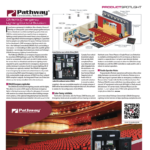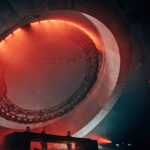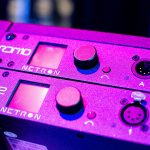Over the last three years, while their Series 2 Syncrolites were out generating revenue on seemingly every production with a budget, the Dallas-based company was busy developing and patenting the next generation of Syncrolite products. Now they’re ready to trot out their Series 3 line of high-powered xenon, moving yoke fixtures with what are possibly the most innovative new features in an automated light in several years.
Flexible Features
Much of the innovation centers on the new OmniColor Scrollers with Dichro Film™ for both additive and subtractive color mixing, along with Variable Field Lenses™, FX Engines™, and FP Gobos™. The colors are actually dichroic filters on flexible substrate, which allow CYM color-mixing in a scrolling device, and they are the basis of the OmniColor patent.
Although thin-film glass dichroic filters have been used in entertainment lighting since the advent of automated lighting in 1981, they have always been manufactured on a high-temperature glass substrate. The proprietary Dichro Film is manufactured on a flexible, high-temperature polymer substrate, which makes them scrollable. As a result, all of the features we’ve come to expect from glass dichroic filters — richly saturated colors and consistent color through the life of the filter — are now available in Syncrolites.
No longer do you have to scroll dark colors back and forth very slowly to keep them from burning up from the intense heat in a Syncrolite. The polymer backing and dichroic thin-film coating can withstand the heat without burning, shrinking or fading. This technology was developed by Rosco Labs and Syncrolite for use in Syncrolite products and will soon be available for other products. The new Syncrolite OmniColor line will be distributed by Rosco.
Like many automated lights, the subtractive color mixing is achieved by combining cyan, yellow and magenta filters. But unlike the others, the Se-ries 3 fixtures also have the ability to synthesize colors by adding pure red, blue and green dichroic color. It does so with side-by-side proportional additive mixing with variable saturation in combination with the CYM color mixing. A homogenizing filter in the third scroller ensures the uni-formity of the mix, resulting in a solidly mixed color. The resulting colors, like the magenta, are very impressive. With all the possible combina-tions, there is a wide palette of useable colors. You can also get split colors by not using the homogenizing filter.

Flexible Lenses
In addition to the color mixing, there are a variety of Syncrolite optical effects that you can use. The Variable Field Lenses (VFL) allow you to vary the field by selecting from the 10-, 20-, or 30-degree stock lens palette or various anamorphics like 60 x 10 and 75 x 95. The interesting thing about these lenses — beside the fact that they are scrollable — is that they introduce very little light loss. They are actually micro lenses on holographic film, and because they are much thinner than a Fresnel lens, they are more efficient than glass at about 92% transmission. They also have a very uniform distribution, creating a flat field. With minimal weight, scrollability and high efficiency, they could have many applications in film, archi-tectural and TV lighting. The company plans to license its OmniColor technology to other manufacturers.
Flexible Effects
There are also a variety of patterns made from Mylar on polymer that allow you to project breakup patterns. Syncrolite calls these soft-edge FP Gobos. You can also customize them by backing them with dichroic film to get multicolored projections. They aren’t designed to reproduce critical images like company logos, but they excel in producing multiple-beam projections and varied surface patterns.
The FX Engines are unique in that a variety of dynamic, animated effects can be generated by combining gobos, colors and a number of effects like flames, waves, moving rings, traveling dots and many more. In fact, custom effects can be created using any pattern applied to the holographic film substrate. By scrolling these patterns across the optical field, the amorphic images move and dart around in the field. It’s like nothing you’ve ever seen.
All of these scroller colors and effects are sonically welded, producing a neat, seemingly indestructible seam unaffected by the intense heat of the xenon lamp. Syncrolite fabricated its own welding machine and patented the process as it applies to scroll manufacturing.
Three Hot Lights
The Series 3 Syncrolites Xenon are available in three sizes: the MX3000 (100,000 lumens) weighing 100 pounds, the SX-B53 (200,000 lumens) weighing 200 pounds and the SXB7-10K-D (500,000 lumens for the 10K). All Syncrolites have an outboard rack-mounted ballast, either magnetic or strobing electronic. The new luminaires also sport a new proprietary reflector that Syncrolite claims increases the light output by 15%–20% and raises the color temperature. Since the Dichro Film can withstand higher temperatures than gel, no IR attenuation from the reflector is required, and by loading the scrollers with CTO or CTB, you can dial in any color temperature. Like the Series 2 fixtures, the Series 3 fixtures can be rigged by one person by opening the road case, flipping the yoke up, rigging the clamp to the truss and flying the truss.
With features like the new OmniColor Dichro Film color mixing and cross fading, aerial beam effects, multicolored pattern projection and ani-mated effects, as well as the higher output and Variable Field Lenses, the Series 3 fixtures are more than a searchlight with a color scroller. The uniformity of the field in the wash mode and the variable color make it a useful lighting tool for long throw key light applications with big uniform flat field and smooth cross-fading washes. The FX Engines, FP Gobos and features like the laser effect via beam overdrive and variable speed strobe, give it an array of interesting looks. And since Syncrolite created the DMX searchlight with scroller and douser in 1989, it makes a great searchlight, too.
What it is: Xenon-source automated lights with dichroic color mixing and effects.
Who it’s for: Anyone who needs a long throw light capable of uniform video wash, color mixing, aerial beam effects, multicolored projections and animated effects.
Pros: New dichroic film allows for additive and subtractive color mixing without fading, new reflector increases output, new effects, uniform wash, one-person rigging.
Cons: Not intended to provide hard edge, hi-res graphics projection.
Cost: P.O.A.


